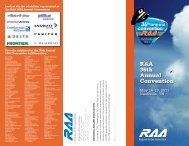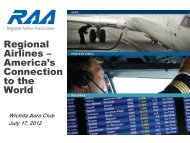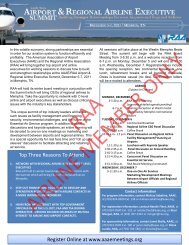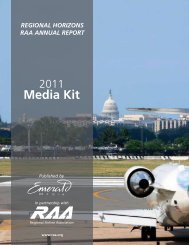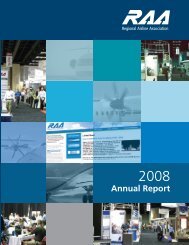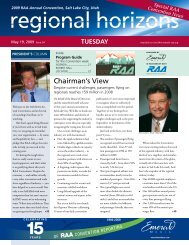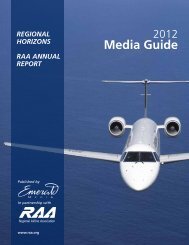Comments - Regional Airline Association
Comments - Regional Airline Association
Comments - Regional Airline Association
You also want an ePaper? Increase the reach of your titles
YUMPU automatically turns print PDFs into web optimized ePapers that Google loves.
incremental kiosk cost estimate is deficient and must be corrected. More importantly, theinformation we received on developing an accessible kiosk to the SNPRM proposed standardsindicates it would not be possible to create a prototype in less than one year. Portions of thePRA validate this development period, as described above. Therefore, there is a disconnectbetween the PRA and the SNPRM; how can the PRA include a $750 incremental cost for aproposed rule that would require accessible kiosk orders 60 days after the final rule when theprototype and cost of an accessible kiosk will not be known for at least one year after the finalrule publication? The Department should compare the accessible kiosk development timeperiods in the PRA (page 25) to the kiosk standard (orders 60 days after the final rule effectivedate) in proposed 382.57(a) and revisit the incremental cost estimate. It will be impossible toplace orders 60 days after the final rule effective date when a prototype will not be available forat least one year.The Department should also consider delaying a final rule until the U.S. Access Board finalizesits Americans with Disabilities Act (“ADA”) Accessibility Guidelines (“ADAAG”) to addressaccessibility of self-service machines such as kiosks used for ticketing, check-in or check-out,seat selection or boarding passes or until the DOJ finalizes its proposal on revisions to its ADAregulations for the accessibility of electronic and information technology equipment andfurniture such as kiosks, interactive transaction machines, point of sale devices and ATMs. Wenote that the Access Board specifically asked in its latest ANPRM whether tactilely discerniblekeys should be the only input method for modern touch screen devices:Question 8: Some modern touch screen devices, such as versions of some smartphonesand tablets, have proved popular with people who are blind, despite not having keyswhich are tactilely discernible. Should the provision requiring that input controls betactilely discernible (407.3) be revised to allow for such novel input methods? Should theBoard add an exception to 407.3 to allow for input controls which are not tactilelydiscernible when access is provided in another way? If so, how should access beaddressed when the controls are not tactilely discernible? Should a particular technologyor method of approach be specified? 17This is another example of technological advances that should be considered before adopting afinal rule and another reason to delay this rulemaking to benefit from information received inother ongoing rulemaking proceedings. 1817 76 Fed. Reg. 76646.18 Even though this question is asked in the context of Information and Communication Technology Standards andGuidelines, the information received on tactilely discernible input methods will be relevant to the part 382 kioskstandards. The Department should not adopt a prescriptive standard that prohibits use of the latest technology.10






